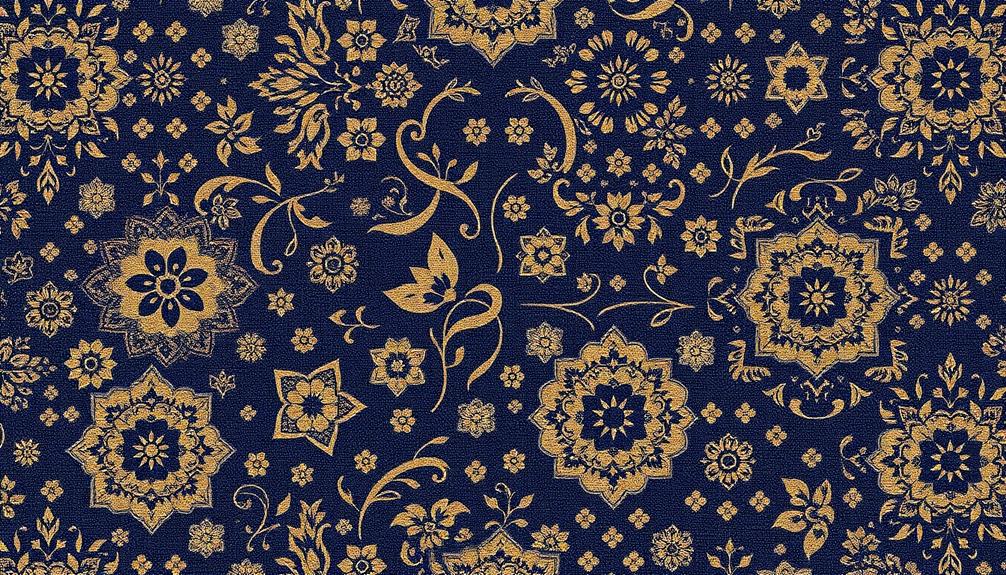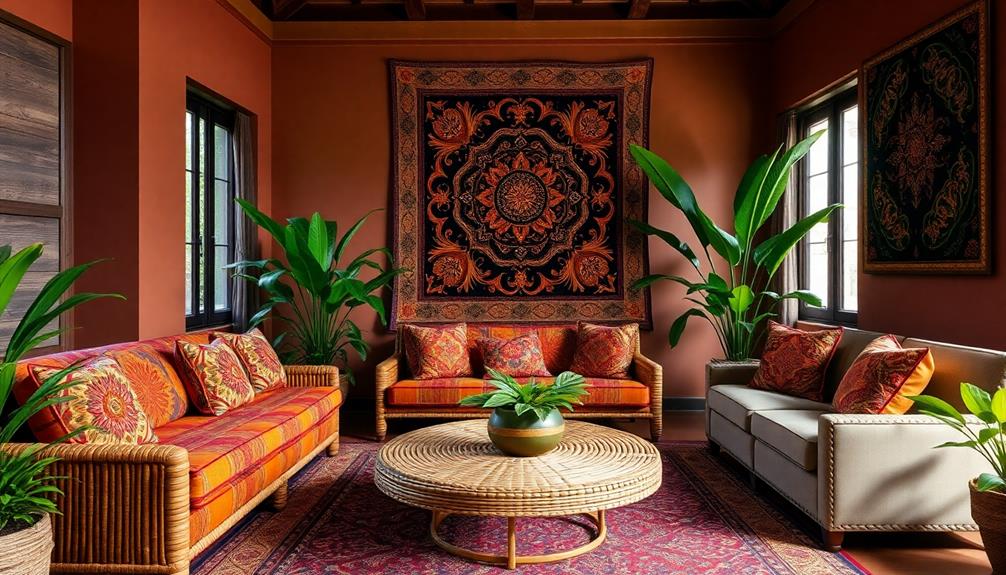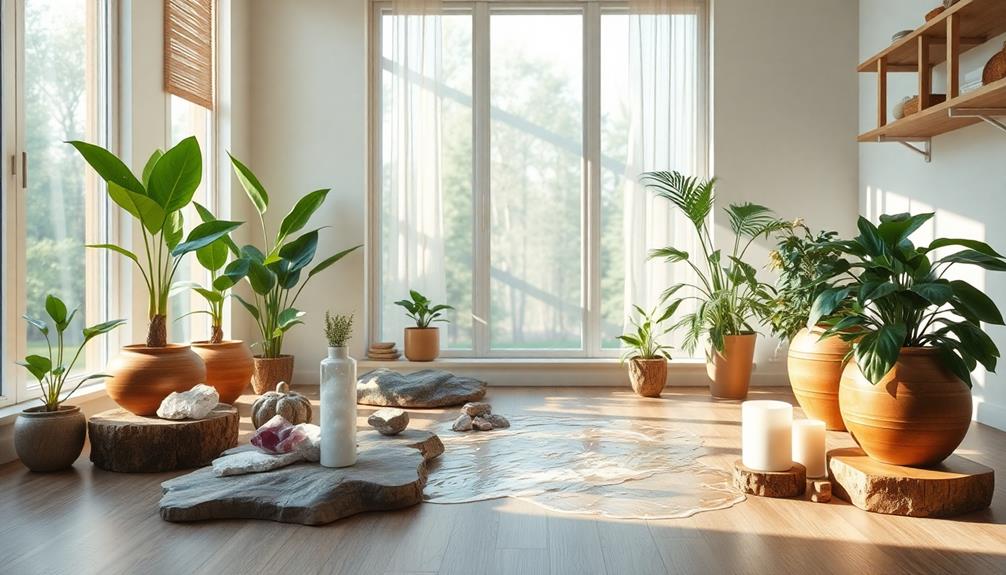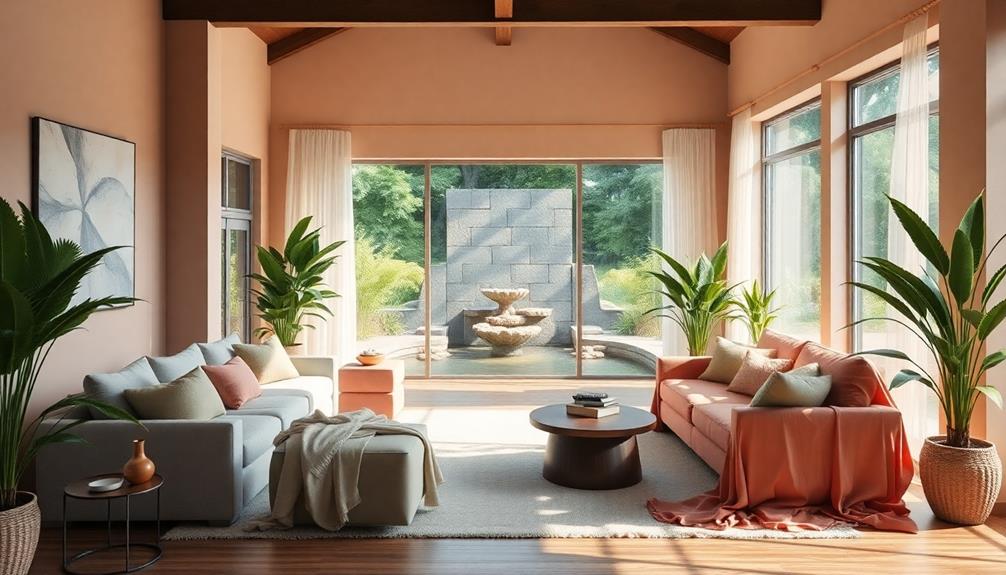Incorporating batik patterns into your home instantly enhances its depth and cultural character. These vibrant textiles, rich in history and storytelling, can be used in various ways. Try adding throw pillows, table linens, or wall hangings featuring intricate designs. Combine batik with other decor styles to create a cohesive look that celebrates cultural heritage. Don't forget to mix solid colors with prints for balance. Using batik in focal pieces can turn your space into a visual narrative of tradition and artistry. Stick around to uncover more tips for beautifully integrating batik elements into your home decor.
Key Takeaways
- Incorporate batik textiles in accent pieces like throw pillows and curtains to showcase intricate patterns and vibrant colors.
- Use batik wall hangings or decorative quilts as focal points to highlight Indonesian artistry and cultural depth.
- Create custom table decor with batik tablecloths and napkins to elevate dining experiences with vibrant, eye-catching prints.
- Mix different batik patterns with solid colors to maintain balance while celebrating rich cultural heritage in your decor.
- Experiment with DIY batik projects, such as wall hangings and framed fabric scraps, to add personal touches and cultural significance to your home.
What Is Batik?
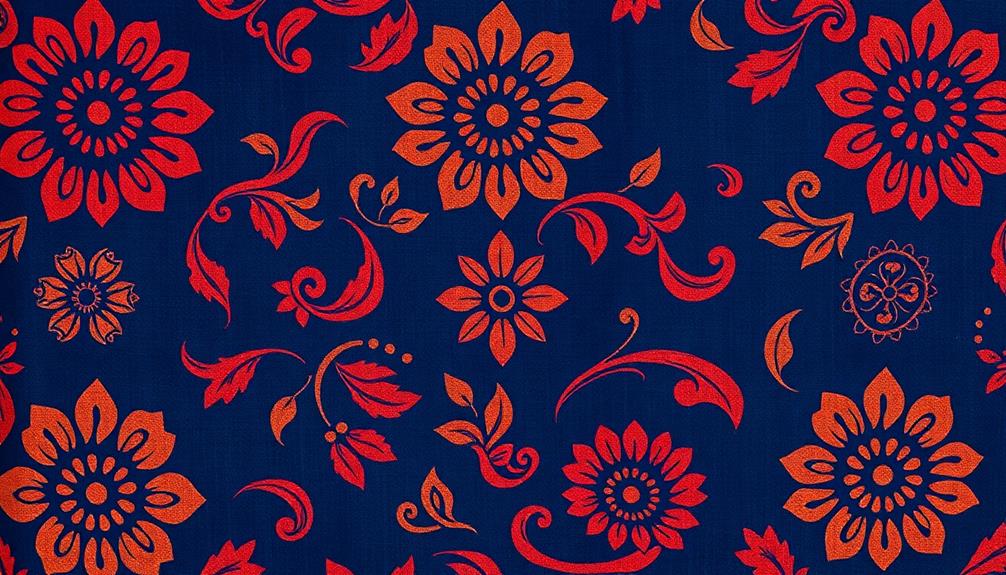
Batik is more than just a textile; it's a vibrant expression of culture and artistry that hails from Indonesia. This traditional art form employs an intricate wax-resist dyeing technique, allowing artisans to create stunning designs on fabric. The term "batik" comes from the Javanese word "bathikan," which means drawing or mark-making, perfectly showcasing the skill involved in its creation.
Additionally, batik shares its cultural significance with Indonesian Decor Masks, which also represent rich heritage and artistry.
There are various batik techniques, including Batik Tulis (hand-drawn), Batik Cap (stamped), and Batik Lukis (painted). Each method differs in labor intensity and style, offering a range of unique patterns.
You'll find that these designs often carry significant cultural meaning, representing social status, nature, and virtues, and may even be reserved for specific occasions.
Recognized by UNESCO as a Masterpiece of the Oral and Intangible Heritage of Humanity, batik remains a crucial expression of cultural identity.
When you choose batik fabric for your home, you're not just adding decor; you're embracing a rich heritage that connects you to a vibrant tradition.
Immerse yourself in the world of batik, and let its enchanting designs enhance your living space.
Historical Significance of Batik
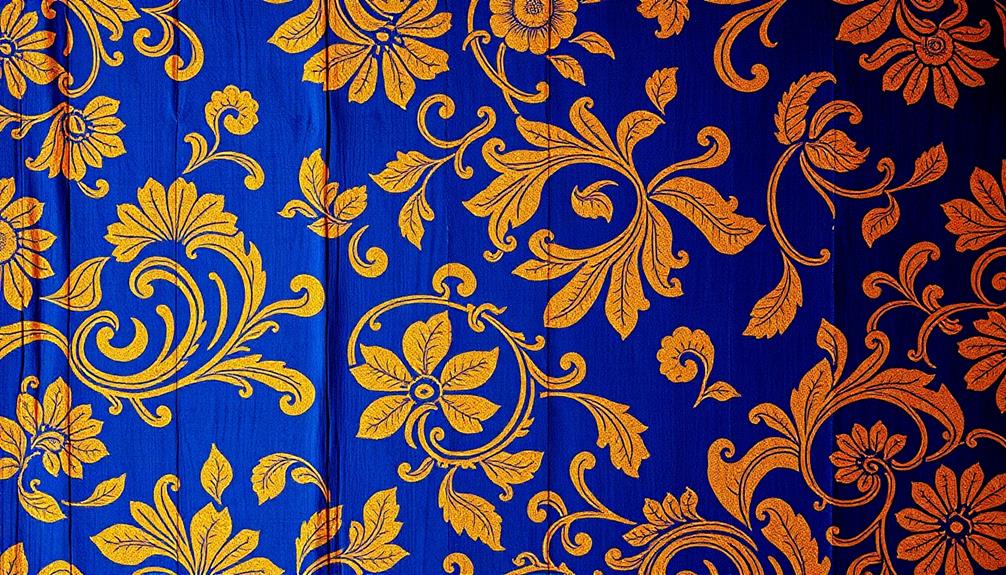
Batik's rich history stretches back over 2,000 years, with roots in ancient Java and significant influences from trade.
This textile art form is characterized by its vibrant colors and intricate patterns that enhance living spaces, making it a favorite choice for Indonesian decorative pillows.
As you explore its cultural heritage, you'll find that each pattern tells a story, often linked to social status and traditions.
Recognized by UNESCO, batik's preservation highlights its importance as a crucial aspect of human expression.
Ancient Origins and Evolution
Tracing back over 2,000 years, the art of batik embodies a rich tapestry of cultural history and craftsmanship. The earliest evidence of batik designs emerged in Java around the 6th century, with artifacts like batik screens found in Japan dating to 700 AD. This technique of wax-resist dyeing developed independently across various cultures, showcasing its widespread appeal.
Remarkably, traditional art forms like Indonesian Decor Masks also celebrate the vibrant storytelling inherent in Indonesian culture.
In ancient Javanese society, traditional batik wasn't just an art form; it represented a deep cultural identity. Originally reserved for royalty, specific motifs were designated for different social classes, effectively reflecting social status. The refined techniques and intricate patterns of Javanese batik evolved considerably after the 1800s when finely woven cloth from India influenced local styles.
Today, batik is recognized as a UNESCO Masterpiece of the Oral and Intangible Heritage of Humanity, emphasizing its historical importance.
As you explore batik designs for your home, remember that each piece carries centuries of tradition and cultural significance, connecting you to a rich legacy that has shaped communities across the globe. Embracing this history adds depth and meaning to your living space.
Cultural Heritage and Symbolism
While exploring the rich tapestry of batik, you'll discover that its cultural heritage and symbolism are woven deeply into the fabric of Indonesian society. Dating back over 2,000 years, batik originated in Java around the 6th century, showcasing its intricate designs that reflect the essence of various communities. Each batik pattern holds meaning, often signifying social status, nature, virtues, or historical narratives.
You'll find that specific traditional patterns are reserved for royalty or significant ceremonies, emphasizing their importance in cultural expression. Additionally, the artistry of batik complements other Indonesian handicrafts, such as the vibrant importance of Indonesian decor masks, enriching the overall cultural experience.
The motifs within batik are intricately linked to festivals, religious events, and the unique identities of diverse ethnic groups. This connection highlights batik's role in preserving cultural heritage, serving as a powerful storytelling medium that conveys messages and traditions.
With thousands of designs existing, every pattern tells a story, making batik more than just decorative art; it's an embodiment of community identity and history. As you incorporate batik into your home, you're not just adding beauty but also celebrating a legacy filled with rich symbolism and meaning, creating a deeper connection to Indonesian culture.
UNESCO Recognition and Preservation
Recognized by UNESCO in 2009 as a Masterpiece of the Oral and Intangible Heritage of Humanity, batik stands as a tribute to Indonesia's rich cultural legacy. Its unesco recognition not only highlights the cultural significance of batik but also emphasizes its traditional craftsmanship, which has been preserved for over 2,000 years.
Originating in Java, batik's intricate patterns and motifs often convey deep meanings, showcasing social status and historical narratives. The art of batik is deeply intertwined with traditional Indonesian housing, as various patterns often reflect the architectural styles and cultural symbols of the regions they come from.
As you explore batik styles, you'll discover distinct regional variations, like Javanese batik, which features elaborate designs that tell stories of the past. These patterns aren't just art; they're a reflection of Indonesia's diverse heritage and the values of its people.
UNESCO's acknowledgment has sparked greater global interest in batik, prompting efforts to preserve these traditions amid modern challenges. By engaging with this art form, you participate in its preservation, ensuring that the knowledge and skills of traditional craftsmanship continue to flourish for future generations.
Embrace batik in your home, and you'll not only add beauty but also honor the enduring cultural significance that this remarkable art embodies.
Types of Batik Techniques
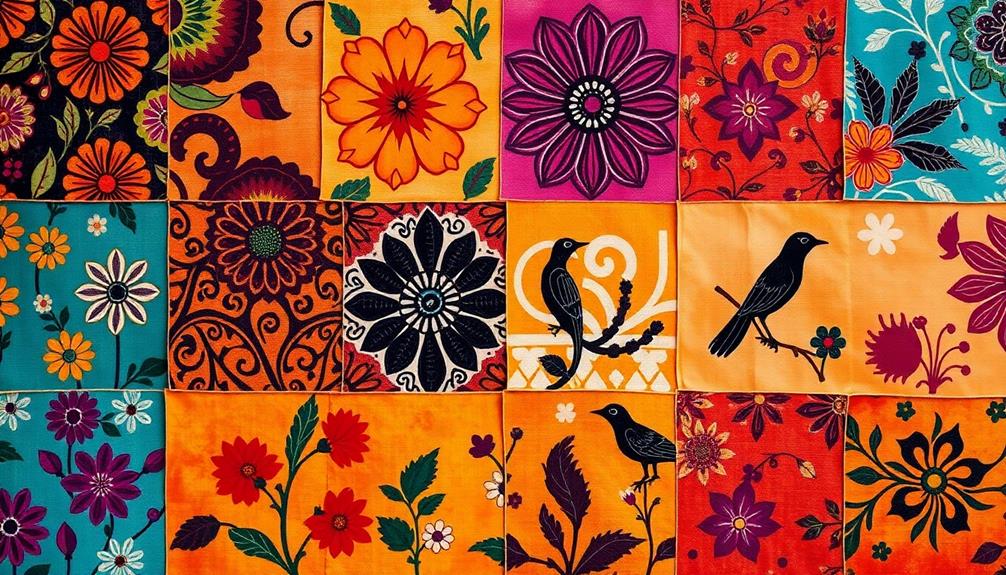
When exploring batik techniques, you'll find a fascinating contrast between Batik Tulis and Batik Cap.
While Tulis showcases intricate, hand-drawn artistry, Cap utilizes copper stamps for quicker production. Both styles reflect the rich cultural heritage of Indonesia, making them a perfect fit for traditional Indonesian style home decor.
Additionally, modern innovations like Batik Lukis are pushing the boundaries of traditional designs, creating vibrant new expressions in fabric art.
Batik Tulis vs. Cap
Batik techniques come in two primary forms: Batik Tulis and Batik Cap, each showcasing unique artistry and craftsmanship. When you explore these methods, you'll notice distinct differences in their processes and outcomes. The rich tradition of Balinese design often reflects similar themes of craftsmanship and cultural significance, making natural materials integral to both.
- Batik Tulis: This hand-drawn technique requires significant skill and time. The intricate designs reflect the artisan's personal touch and cultural storytelling, making it the purest form of batik.
- Batik Cap: Utilizing copper stamps for wax application, this technique allows for quicker production and uniformity. It's recognized by UNESCO for its cultural significance and accessibility to a wider audience.
- Texture and Depth: Batik Tulis often results in a more varied texture and depth due to the hand application of wax, while Batik Cap focuses on replicating popular motifs efficiently.
Understanding these differences helps you appreciate the beauty and labor behind each piece.
Whether you prefer the intricate designs of Batik Tulis or the efficiency of Batik Cap, both techniques add depth and culture to your home, making them valuable additions to your decor.
Modern Batik Innovations
Artistry in modern batik has evolved considerably, showcasing innovative techniques that blend tradition with contemporary expression.
One of the most traditional forms, Batik Tulis, uses a canting tool for intricately detailed, hand-drawn designs, reflecting an artisan's unique skill. In contrast, Batik Cap employs copper stamps, allowing for quicker production of uniform designs while preserving batik's cultural essence, earning UNESCO recognition.
These techniques can beautifully complement the serene and inviting spaces created by luxury tropical designs in Bali.
Batik Lukis takes a bold step forward by allowing artists to paint directly on batik fabrics. This freeform artistic expression diverges from traditional wax-resist techniques, yet honors the batik style.
Meanwhile, Batik Pesisir, originating from coastal regions, combines vibrant colors and commercial influences, appealing to modern tastes and blending local and foreign artistic elements.
Lastly, Batik Belanda illustrates the adaptability of batik, merging Dutch and Javanese styles to create a fusion of Western motifs with traditional patterns.
Each of these modern batik innovations reflects a dynamic evolution, ensuring that batik remains relevant and cherished in today's world.
Embrace these techniques to enrich your home with depth and culture.
Cultural Symbols in Batik
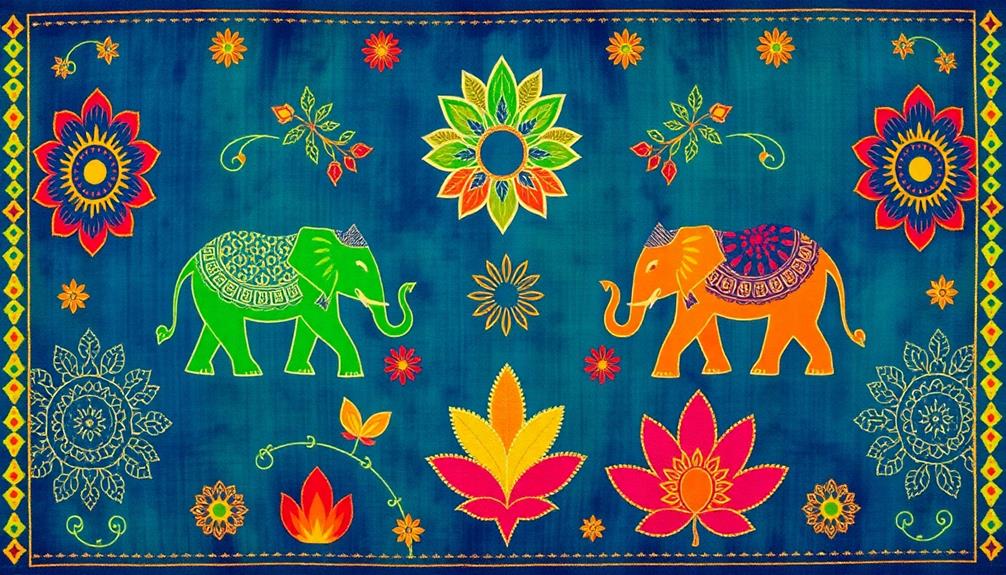
Cultural symbols woven into batik patterns carry deep meanings that reflect the heritage and beliefs of the people who create them. Each design tells a story, showcasing the rich tapestry of Indonesian culture, which is also evident in the diverse architectural styles found throughout the country.
For instance, the "parang" motif symbolizes strength and is traditionally reserved for royalty, while the "kawung" design signifies universal harmony, often used in ceremonial contexts. This connection between art and architecture highlights the importance of cultural preservation, as seen in traditional housing styles.
Here are some key aspects of cultural symbols in batik:
- Regional Diversity: Different regions in Indonesia showcase unique motifs, with coastal batik incorporating foreign influences, and inland designs preserving traditional elements.
- Social Significance: Certain patterns are tied to social status and specific occasions, reinforcing cultural identity and values.
- Storytelling Medium: Batik serves as a canvas for historical events, myths, and nature, making it a living narrative of the community.
As you explore batik patterns, remember that these cultural symbols, rooted in the Javanese word for "to write," hold the essence of identity and tradition.
Whether you're visiting a design studio or shopping for textiles, appreciate the stories behind each piece.
Incorporating Batik in Home Decor
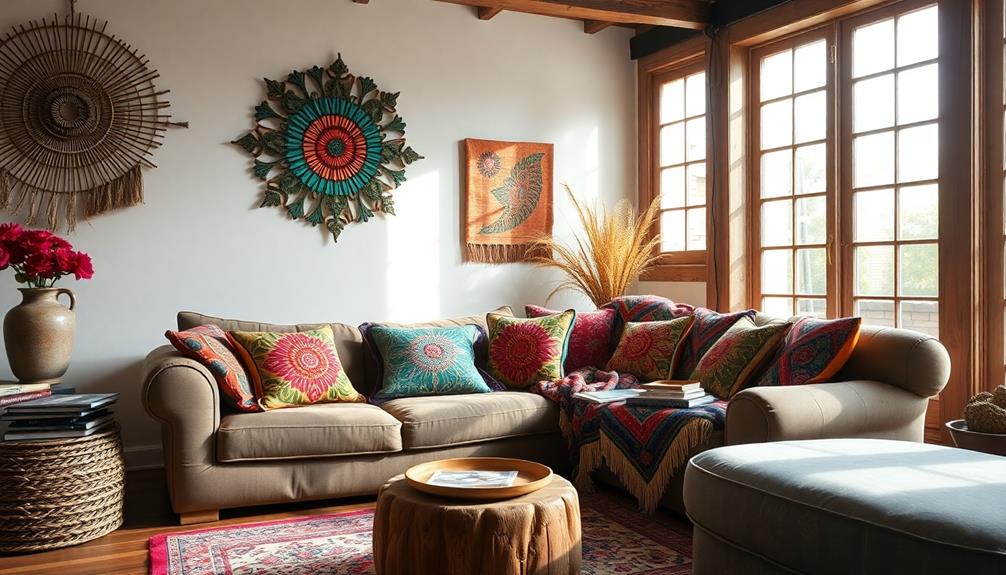
Transforming your living space with batik can add a vibrant cultural flair that's both inviting and unique. You can easily incorporate batik textiles into your home decor by using them as accent pieces. Think throw pillows, curtains, or table linens that showcase the intricate patterns and colors of this traditional fabric.
For a more immersive experience, consider blending batik with other Indonesian decor elements, such as floral arrangements featuring native blooms, to create a cohesive look that celebrates rich cultural heritage traditional Indonesian decor ideas.
To create a harmonious look, mix different patterns and colors, pairing them with solid hues to maintain balance and avoid overwhelming your space. Batik can also serve as stunning focal points when featured prominently as wall-mounted panels or decorative quilts, celebrating Indonesian heritage and artistry.
For a more subtle approach, consider using batik motifs in home accessories like coasters and lampshades. These small touches allow for impactful cultural expressions while enhancing your overall aesthetic.
If you're feeling creative, you can explore DIY projects by creating custom wall art or upcycling furniture with batik upholstery, showcasing unique designs that reflect craftsmanship.
DIY Batik Projects
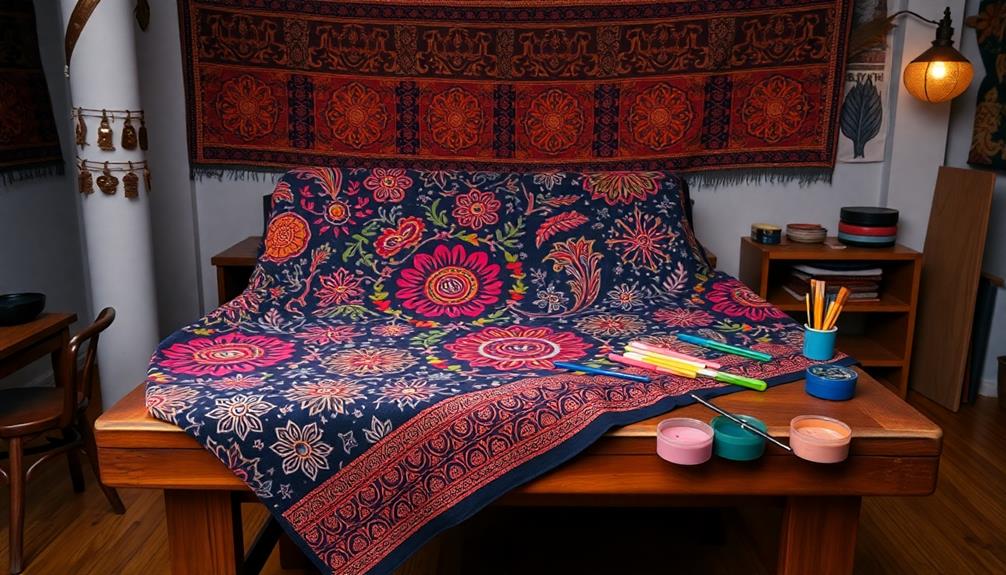
You can easily transform your space with unique batik wall hangings that showcase stunning patterns.
Consider creating vibrant table decor, like custom tablecloths and napkins, to elevate your dining experience.
These DIY projects not only add color and culture to your home but also let your creativity shine.
Unique Batik Wall Hangings
Have you ever considered how unique batik wall hangings can elevate your space?
These stunning pieces not only highlight the intricate patterns of this traditional art form but also add depth and cultural significance to your home decor.
By framing fabric scraps, you can create polished wall hangings that serve as focal points in any room.
Here are a few ideas to inspire your DIY batik wall hangings:
- Experiment with Sizes: Mix different sizes of batik pieces to create a dynamic gallery wall effect, enhancing visual interest.
- Layer with Natural Elements: Combine batik fabric with wood accents for a rustic touch that complements the vibrant colors and textures of the textile.
- Incorporate Cultural Motifs: Use batik designs that reflect cultural stories and heritage, adding meaningful depth to your interior design.
Vibrant Batik Table Decor
Building on the charm of unique batik wall hangings, vibrant batik table decor can further enhance your home's aesthetic and cultural appeal. By creating custom tablecloths and runners with eye-catching batik prints, you can transform your dining area into a focal point during gatherings. Pair these with matching batik napkins to showcase the intricate patterns and colors, achieving a cohesive look.
Consider waterproofing your batik table linens for outdoor events, ensuring they stay beautiful while adding a festive atmosphere. Celebrate special occasions with traditional motifs that highlight your cultural heritage and elevate the significance of the event.
To inspire your creativity, here's a quick reference table for vibrant batik table decor ideas:
| Batik Element | Description |
|---|---|
| Tablecloths | Custom prints to enhance the table setting |
| Table Runners | Layered designs for added dimension |
| Napkins | Matching colors to complete the look |
| Waterproof Linens | Ideal for outdoor events |
| Mixed Patterns | Experiment with textures for uniqueness |
With these ideas, you'll create a vibrant batik table decor that reflects your personal style while celebrating this beautiful art form.
Batik Textiles for Modern Interiors
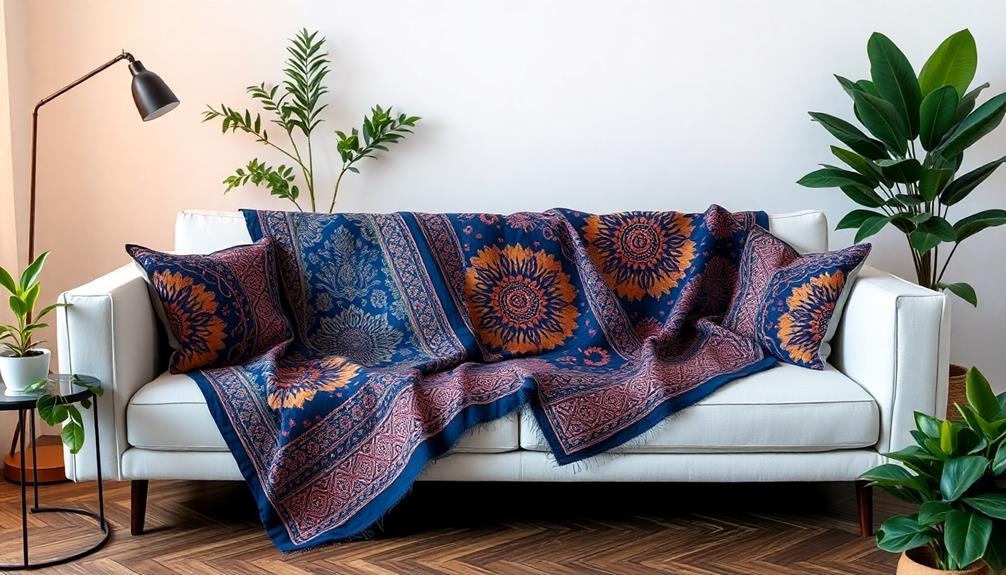
Batik textiles bring a vibrant touch to modern interiors, weaving together cultural narratives and intricate designs that elevate any space. By incorporating these textiles, you can create a harmonious blend of tradition and contemporary aesthetics, showcasing the artistry behind each piece.
Here are some effective ways to use batik textiles in your home:
- Focal Points: Use batik wall hangings or oversized cushions to draw the eye and celebrate unique designs.
- Versatile Applications: Incorporate batik into throws, curtains, or upholstery, adding depth and character while ensuring a cohesive look.
- Eclectic Combinations: Mix batik patterns with solid colors to maintain balance and avoid overwhelming your decor.
Moreover, choosing batik textiles aligns with sustainable practices, as many artisans adopt eco-friendly methods in production. This not only supports local heritage but also contributes to a more environmentally conscious lifestyle.
Choosing the Right Batik Patterns
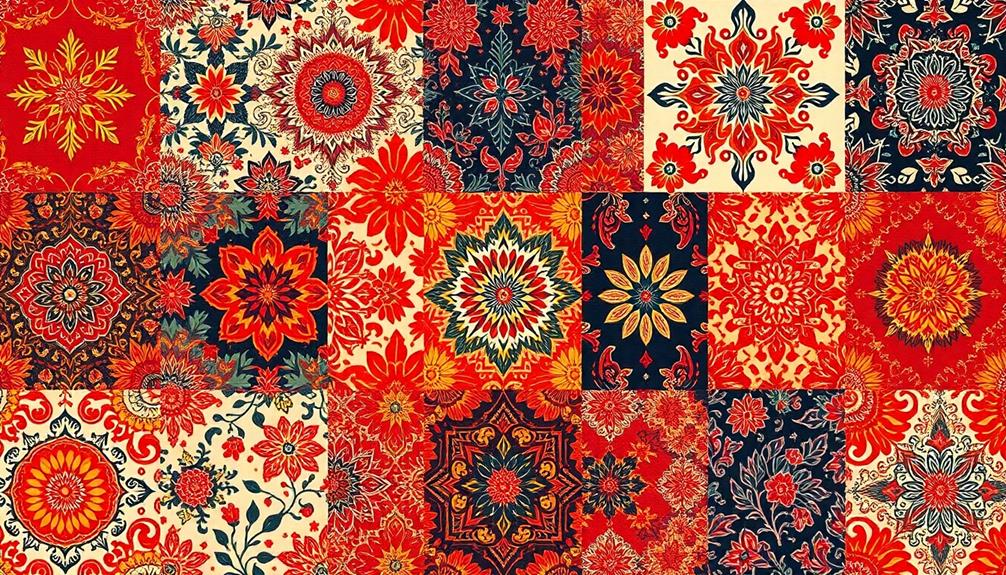
Incorporating batik textiles into your home is just the beginning; choosing the right patterns is essential to achieving the desired aesthetic and cultural resonance. When selecting batik, consider the cultural significance of the motifs. Some designs symbolize social status or nature, with specific patterns, like the parang, reserved for royalty in Indonesian culture.
For authenticity and uniqueness, opt for hand-drawn Batik, known as Batik Tulis. Its intricate designs can add a rich, personal touch to your decor. If you prefer uniformity, Batik Cap offers a modern, streamlined appearance that works well in contemporary spaces.
Don't overlook the colors; traditional batik often features earthy tones like indigo, brown, and beige, which can seamlessly complement various interior color schemes. These hues can enhance the warmth in your home while providing a grounded feel.
Mixing batik patterns with solid colors creates a balanced aesthetic. Use batik as accent pieces—think cushions or wall art—to introduce dynamic visual interest without overwhelming the room.
Caring for Batik Fabrics
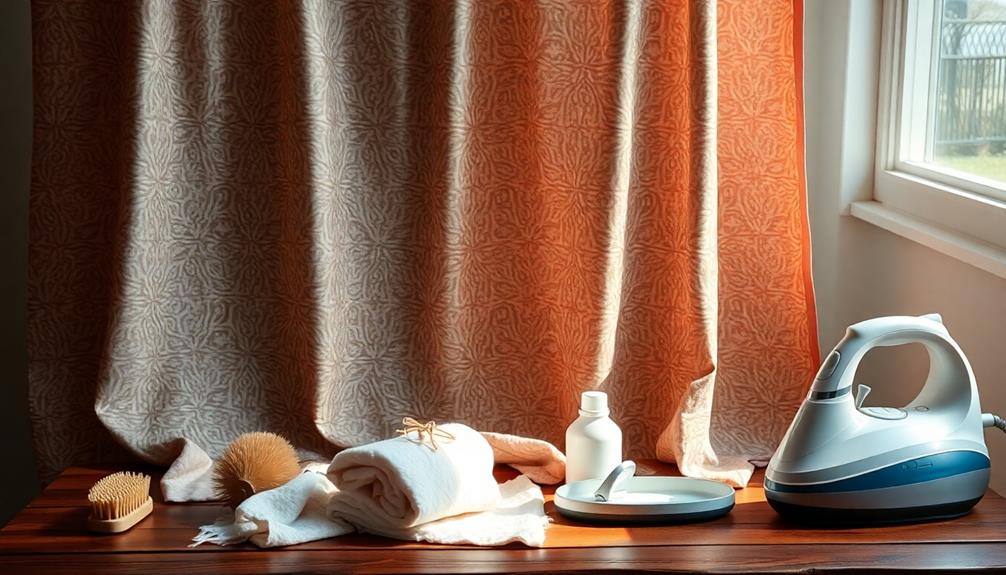
To keep your batik fabrics looking their best, it's essential to follow a few simple care guidelines. Caring for batik fabrics properly guarantees that their vibrant colors and intricate patterns last for years.
Here's what you need to remember:
- Wash with care: Always hand wash batik fabrics in cold water using a mild detergent. Avoid hot water, bleach, and harsh chemicals, as they can damage the wax-resist dyeing technique.
- Dry gently: Lay the fabric flat or hang it in a shaded area to dry. Direct sunlight can fade those beautiful colors over time.
- Iron wisely: When you need to iron batik fabrics, use a low-temperature setting. Place a cloth or thin layer of fabric between the iron and the batik to protect the wax designs.
Additionally, it's important to store batik items properly. Keep them in a cool, dry place away from direct light, ideally wrapped in acid-free tissue paper.
This will help prevent creasing and preserve their quality, guaranteeing that your batik fabrics remain stunning for any occasion.
The Future of Batik Artistry

Caring for batik fabrics not only protects their beauty but also supports the ongoing legacy of batik artistry. The future of batik art hinges on preserving traditional techniques while adapting to modern tastes.
As globalization and mass production threaten traditional craftsmanship, economic viability for artisans becomes essential. You can help by choosing batik items that prioritize authentic artistry over mass-produced alternatives.
Collaborative efforts between artisans and digital platforms open up marketing avenues, enabling Hmong artisans to reach global audiences and improve their livelihoods. By supporting these initiatives, you guarantee the survival of this intricate art form in a modern context.
Moreover, there's a growing trend towards sustainable practices in batik production. Consumers like you are increasingly seeking eco-friendly and ethically produced textiles, encouraging artisans to adopt sustainable methods.
Education and awareness initiatives play a significant role in passing down batik skills to new generations. By engaging with these programs, you can foster appreciation and respect for batik, maintaining its cultural relevance amidst modernization pressures.
Celebrate batik artistry by embracing its rich heritage and supporting its future.
Frequently Asked Questions
What Are the Three Main Elements of Batik Pattern?
The three main elements of batik patterns are motifs, colors, and design techniques. You'll find motifs tell cultural stories, colors come from natural sources, and design techniques include hand-drawn and stamped methods for unique textures.
What Are the 5 Major Types of Batik Design Motif?
Did you know that over 1,000 batik motifs exist? The five major types you'll encounter include Parang, Kawung, Batik Tulis, Batik Cap, and Batik Pesisir, each reflecting unique cultural significance and artistic expression.
What Are the Four Types of Batik?
You'll find four main types of batik: Batik Tulis, the hand-drawn version; Batik Cap, stamped for efficiency; Batik Lukis, painted for creativity; and Batik Pesisir, which features vibrant, coastal-inspired designs. Each offers unique charm.
What Does Batik Symbolize?
Batik symbolizes cultural identity, social status, and nature. Each design you see carries deep meanings, reflecting values like power, growth, and community heritage. By incorporating these patterns, you connect with a rich cultural narrative.
Conclusion
Incorporating batik into your home decor isn't just about aesthetics; it's a nod to a rich tapestry of culture and history. Like a brushstroke in a masterpiece, each pattern invites you to explore its story and significance. By choosing the right elements, you transform your space into a sanctuary of depth and meaning. So, as you embrace the beauty of batik, remember that you're not just decorating—you're weaving a narrative that echoes through time.
